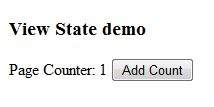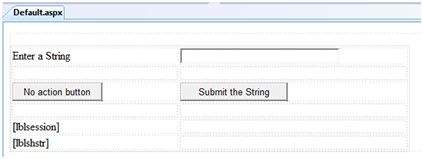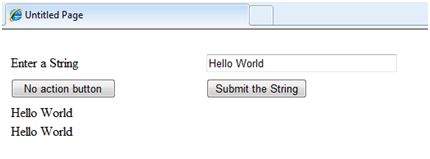Hyper Text Transfer Protocol (HTTP) is a stateless protocol. When the
client disconnects from the server, the ASP.NET engine discards the
page objects. This way, each web application can scale up to serve
numerous requests simultaneously without running out of server memory.
However, there needs to be some technique to store the information between requests and to retrieve it when required. This information i.e., the current value of all the controls and variables for the current user in the current session is called the State.
ASP.NET manages four types of states:
When a page is sent back to the client, the changes in the properties of the page and its controls are determined, and stored in the value of a hidden input field named _VIEWSTATE. When the page is again posted back, the _VIEWSTATE field is sent to the server with the HTTP request.
The view state could be enabled or disabled for:
The StateBag class has the following properties:
The StateBag class has the following methods:
The markup file code is as follows:

Session state is generally used for storing application data such as inventory, supplier list, customer record, or shopping cart. It can also keep information about the user and his preferences, and keep the track of pending operations.
Sessions are identified and tracked with a 120-bit SessionID, which is passed from client to server and back as cookie or a modified URL. The SessionID is globally unique and random.
The session state object is created from the HttpSessionState class, which defines a collection of session state items.
The HttpSessionState class has the following properties:
The HttpSessionState class has the following methods:
The session state object is a name-value pair to store and retrieve
some information from the session state object. You could use the
following code for the same:
The mark up file code is as follows:
 The code behind file is given here:
The code behind file is given here:

To provide for the use of application state, ASP.NET creates an application state object for each application from the HTTPApplicationState class and stores this object in server memory. This object is represented by class file global.asax.
Application State is mostly used to store hit counters and other statistical data, global application data like tax rate, discount rate etc. and to keep the track of users visiting the site.
The HttpApplicationState class has the following properties:
The HttpApplicationState class has the following methods:
Application state data is generally maintained by writing handlers for the events:
However, there needs to be some technique to store the information between requests and to retrieve it when required. This information i.e., the current value of all the controls and variables for the current user in the current session is called the State.
ASP.NET manages four types of states:
- View State
- Control State
- Session State
- Application State
View State
The view state is the state of the page and all its controls. It is automatically maintained across posts by the ASP.NET framework.When a page is sent back to the client, the changes in the properties of the page and its controls are determined, and stored in the value of a hidden input field named _VIEWSTATE. When the page is again posted back, the _VIEWSTATE field is sent to the server with the HTTP request.
The view state could be enabled or disabled for:
- The entire application by setting the EnableViewState property in the <pages> section of web.config file.
- A page by setting the EnableViewState attribute of the Page directive, as <%@ Page Language="C#" EnableViewState="false" %>
- A control by setting the Control.EnableViewState property.
The StateBag class has the following properties:
| Properties | Description |
|---|---|
| Item(name) | The value of the view state item with the specified name. This is the default property of the StateBag class. |
| Count | The number of items in the view state collection. |
| Keys | Collection of keys for all the items in the collection. |
| Values | Collection of values for all the items in the collection. |
| Methods | Description |
|---|---|
| Add(name, value) | Adds an item to the view state collection and existing item is updated. |
| Clear | Removes all the items from the collection. |
| Equals(Object) | Determines whether the specified object is equal to the current object. |
| Finalize | Allows it to free resources and perform other cleanup operations. |
| GetEnumerator | Returns an enumerator that iterates over all the key/value pairs of the StateItem objects stored in the StateBag object. |
| GetType | Gets the type of the current instance. |
| IsItemDirty | Checks a StateItem object stored in the StateBag object to evaluate whether it has been modified. |
| Remove(name) | Removes the specified item. |
| SetDirty | Sets the state of the StateBag object as well as the Dirty property of each of the StateItem objects contained by it. |
| SetItemDirty | Sets the Dirty property for the specified StateItem object in the StateBag object. |
| ToString | Returns a string representing the state bag object. |
Example
The following example demonstrates the concept of storing view state. Let us keep a counter, which is incremented each time the page is posted back by clicking a button on the page. A label control shows the value in the counter.The markup file code is as follows:
<%@ Page Language="C#" AutoEventWireup="true" CodeBehind="Default.aspx.cs" Inherits="statedemo._Default" %> <!DOCTYPE html PUBLIC "-//W3C//DTD XHTML 1.0 Transitional//EN" "http://www.w3.org/TR/xhtml1/DTD/xhtml1-transitional.dtd"> <html xmlns="http://www.w3.org/1999/xhtml" > <head runat="server"> <title> Untitled Page </title> </head> <body> <form id="form1" runat="server"> <div> <h3>View State demo</h3> Page Counter: <asp:Label ID="lblCounter" runat="server" /> <asp:Button ID="btnIncrement" runat="server" Text="Add Count" onclick="btnIncrement_Click" /> </div> </form> </body> </html>The code behind file for the example is shown here:
public partial class _Default : System.Web.UI.Page { public int counter { get { if (ViewState["pcounter"] != null) { return ((int)ViewState["pcounter"]); } else { return 0; } } set { ViewState["pcounter"] = value; } } protected void Page_Load(object sender, EventArgs e) { lblCounter.Text = counter.ToString(); counter++; } }It would produce the following result:

Control State
Control state cannot be modified, accessed directly, or disabled.Session State
When a user connects to an ASP.NET website, a new session object is created. When session state is turned on, a new session state object is created for each new request. This session state object becomes part of the context and it is available through the page.Session state is generally used for storing application data such as inventory, supplier list, customer record, or shopping cart. It can also keep information about the user and his preferences, and keep the track of pending operations.
Sessions are identified and tracked with a 120-bit SessionID, which is passed from client to server and back as cookie or a modified URL. The SessionID is globally unique and random.
The session state object is created from the HttpSessionState class, which defines a collection of session state items.
The HttpSessionState class has the following properties:
| Properties | Description |
|---|---|
| SessionID | The unique session identifier. |
| Item(name) | The value of the session state item with the specified name. This is the default property of the HttpSessionState class. |
| Count | The number of items in the session state collection. |
| TimeOut | Gets and sets the amount of time, in minutes, allowed between requests before the session-state provider terminates the session. |
| Methods | Description |
|---|---|
| Add(name, value) | Adds an item to the session state collection. |
| Clear | Removes all the items from session state collection. |
| Remove(name) | Removes the specified item from the session state collection. |
| RemoveAll | Removes all keys and values from the session-state collection. |
| RemoveAt | Deletes an item at a specified index from the session-state collection. |
void StoreSessionInfo() { String fromuser = TextBox1.Text; Session["fromuser"] = fromuser; } void RetrieveSessionInfo() { String fromuser = Session["fromuser"]; Label1.Text = fromuser; }The above code stores only strings in the Session dictionary object, however, it can store all the primitive data types and arrays composed of primitive data types, as well as the DataSet, DataTable, HashTable, and Image objects, as well as any user-defined class that inherits from the ISerializable object.
Example
The following example demonstrates the concept of storing session state. There are two buttons on the page, a text box to enter string and a label to display the text stored from last session.The mark up file code is as follows:
<%@ Page Language="C#" AutoEventWireup="true" CodeFile="Default.aspx.cs" Inherits="_Default" %> <!DOCTYPE html PUBLIC "-//W3C//DTD XHTML 1.0 Transitional//EN" "http://www.w3.org/TR/xhtml1/DTD/xhtml1-transitional.dtd"> <html xmlns="http://www.w3.org/1999/xhtml" > <head runat="server"> <title> Untitled Page </title> </head> <body> <form id="form1" runat="server"> <div> <table style="width: 568px; height: 103px"> <tr> <td style="width: 209px"> <asp:Label ID="lblstr" runat="server" Text="Enter a String" style="width:94px"> </asp:Label> </td> <td style="width: 317px"> <asp:TextBox ID="txtstr" runat="server" style="width:227px"> </asp:TextBox> </td> </tr> <tr> <td style="width: 209px"> </td> <td style="width: 317px"> </td> </tr> <tr> <td style="width: 209px"> <asp:Button ID="btnnrm" runat="server" Text="No action button" style="width:128px" /> </td> <td style="width: 317px"> <asp:Button ID="btnstr" runat="server" OnClick="btnstr_Click" Text="Submit the String" /> </td> </tr> <tr> <td style="width: 209px"> </td> <td style="width: 317px"> </td> </tr> <tr> <td style="width: 209px"> <asp:Label ID="lblsession" runat="server" style="width:231px" > </asp:Label> </td> <td style="width: 317px"> </td> </tr> <tr> <td style="width: 209px"> <asp:Label ID="lblshstr" runat="server"> </asp:Label> </td> <td style="width: 317px"> </td> </tr> </table> </div> </form> </body> </html>It should look like the following in design view:
 The code behind file is given here:
The code behind file is given here:public partial class _Default : System.Web.UI.Page { String mystr; protected void Page_Load(object sender, EventArgs e) { this.lblshstr.Text = this.mystr; this.lblsession.Text = (String)this.Session["str"]; } protected void btnstr_Click(object sender, EventArgs e) { this.mystr = this.txtstr.Text; this.Session["str"] = this.txtstr.Text; this.lblshstr.Text = this.mystr; this.lblsession.Text = (String)this.Session["str"]; } }Execute the file and observe how it works:

Application State
The ASP.NET application is the collection of all web pages, code and other files within a single virtual directory on a web server. When information is stored in application state, it is available to all the users.To provide for the use of application state, ASP.NET creates an application state object for each application from the HTTPApplicationState class and stores this object in server memory. This object is represented by class file global.asax.
Application State is mostly used to store hit counters and other statistical data, global application data like tax rate, discount rate etc. and to keep the track of users visiting the site.
The HttpApplicationState class has the following properties:
| Properties | Description |
|---|---|
| Item(name) | The value of the application state item with the specified name. This is the default property of the HttpApplicationState class. |
| Count | The number of items in the application state collection. |
| Methods | Description |
|---|---|
| Add(name, value) | Adds an item to the application state collection. |
| Clear | Removes all the items from the application state collection. |
| Remove(name) | Removes the specified item from the application state collection. |
| RemoveAll | Removes all objects from an HttpApplicationState collection. |
| RemoveAt | Removes an HttpApplicationState object from a collection by index. |
| Lock() | Locks the application state collection so only the current user can access it. |
| Unlock() | Unlocks the application state collection so all the users can access it. |
- Application_Start
- Application_End
- Application_Error
- Session_Start
- Session_End
Void Application_Start(object sender, EventArgs e) { Application["startMessage"] = "The application has started."; } Void Application_End(object sender, EventArgs e) { Application["endtMessage"] = "The application has ended."; }

aws training in bangalore
ReplyDeleteartificial intelligence training in bangalore
machine learning training in bangalore
blockchain training in bangalore
iot training in bangalore
artificial intelligence certification
artificial intelligence certification
python training in bangalore | python online training
ReplyDeleteaws training in Bangalore | aws online training
artificial intelligence training in bangalore
| artificial intelligence online training
machine learning training in bangalore | machine learning online training
data science training in bangalore | data science online training